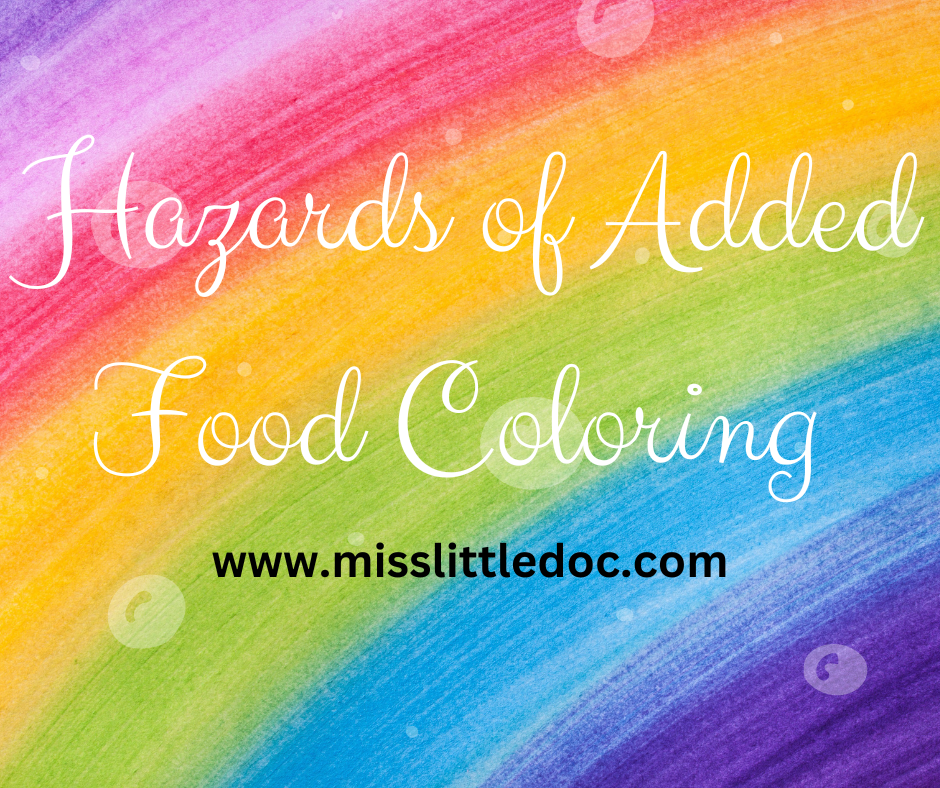Food Coloring
Food dyes are everywhere. If you are a label reader you will start noticing how many products have extra added color in them. Simple things like cough syrup, medicines, candy, chips, a ton of packaged food, icings, baked goods, sodas and even salad dressing. In the early 1900s, food manufacturers started to add artificial coloring to foods for extra appeal.
There is a lot of thought about the safety of food dyes. The market offers products “with no added dyes”. So it comes to mention that maybe there could be health concerns, especially in children and pregnant women.
Food dyes
Artificial dyes were mostly added to look more appealing and attractive to consumers. They mask the absence of natural ingredients, such as fruit and they are much cheaper to produce. Added coloring can be much brighter than natural coloring.
There are nine synthetic dyes that the FDA currently approves for use in food:
- Blue 1 (Brilliant Blue)
- Blue 2 (Indigo Carmine)
- Citrus Red 2
- Green 3 (Fast Green FCF)
- Orange B (No longer used in the U.S., but was never officially banned)
- Red 3 (Erythrosine)
- Red 40 (Allura Red)
- Yellow 5 (Tartrazine)
- Yellow 6 (Sunset Yellow)

Foods usually contain more than one dye in them. Foods such as cereal, ice cream, candy, and toaster pastries contain all 6 of the most commonly used artificial food colors (Blue 1, Blue 2, Red 3, Red 40, Yellow 5, & Yellow 6).
US FDA concluded that most children have no adverse effects when consuming foods containing color additives, but some evidence suggests that certain children may be sensitive to them. Color additives are derived from petroleum and are listed on the products ingredient label.
In one study it concluded, “The scientific literature provides evidence in humans and animals, as well as mechanistic information, that synthetic food dyes may cause or exacerbate neuro- behavioral problems in some children. Data from multiple evidence streams, including epidemiology, animal neurotoxicology, in vitro and high throughput assays providing mechanistic insight, taken together, provide support that some FD&C batch-certified synthetic food dyes impact neurobehavior in children.” –Health Effects Assessment: Potential Neurobehavioral Effects of Synthetic Food Dyes in Children
In a “Rainbow of Risks” they conclude that: Blue 2 should not be considered safe because of the evidence of tumors. Green 3 caused bladder and testes tumors in rodents. Red 40 causes hypersensitivity in children and allergy-like symptoms. Yellow 5 causes hyperactivity and other behavioral problems in children. Yellow 6 caused adrenal tumors in animals and occasionally causes severe hypersensitivity reactions.
Yellow 5 has also been linked to exacerbating lung conditions. So if you have asthma or any type of lung issues, stay away from things like Mountain Dew, some jellos, Kool-Aids, and breakfast cereals (along with others, check your labels.)
What to do instead
Instead of choosing a food with multiple food dyes, choose one with no added dyes or ones with natural coloring. Give it 2 weeks and see how your children’s temperaments change. Or how you feel after kicking the dyes to the curb. Make sure you check labels, they hide everywhere! For cakes, check out how to make natural food coloring! There are all kinds of things on the internet on how to make your own colors.
There are many ways to get healthier in the new year. Changing out laundry soaps, ditching the junk food and eating real food, cooking home cooked meals, opt for shampoo with no harsh additives, drink more water, or even start a small exercise routine. Find a good chiropractor near you! Your spine is the highway to health in your body. If you have any issues in the body, they can correspond back to the spine and what you are putting into and on your body!
Chiropractic care is full body health. Most issues can be treated by chiropractic care. If you have any questions on how chiropractic can help you, give us or a chiropractor near you a call!
~Dr. Lacey~
Carder Chiropractic Clinic, INC.
El Reno, OK 73036



